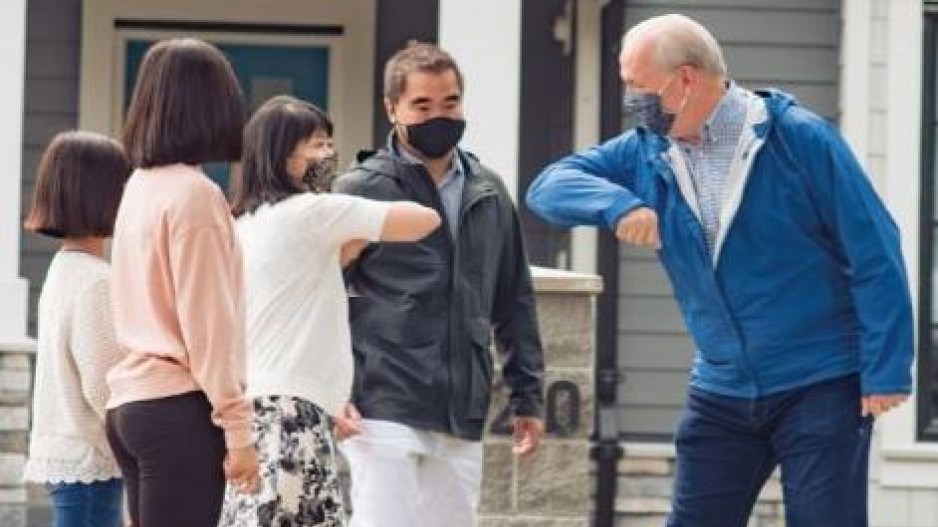If British Columbians want to know what an election during a pandemic might look like, they need look no farther than New Brunswick.
On September 14, the Progressive Conservatives – which had a feeble minority supported by the People’s Alliance – won a majority.
All of the traditional ways of campaigning – door-knocking, glad-handing, fundraising dinners, local candidate debates – are out the window, due to state-of-emergency measures that limit social interaction, and a virtual campaign is likely to favour the party in power.
“The example from New Brunswick is inherently cruel,” said Mario Canseco, president of polling firm Research Co. “You have someone, (Kevin) Vickers, running for the Liberals, and because of the constraints of the campaign – he can’t knock on doors, he’s got to do everything online -- and he ends up losing his riding.”
John Horgan’s NDP also enjoys a healthy approval rating.
Canseco points to his company’s polling which shows high satisfaction with the NDP government’s handling of the pandemic. At the end of May, his firm’s polling found 41% of decided voters favouring the NDP. The Liberals had just 33% of the decided vote.
A September 4 Angus Reid poll, meanwhile, put the NDP in B.C. at 48% for the decided vote, the Liberals 29% and the Greens 14%.
The BC Liberals will be fighting an election at a serious disadvantage.
“The type of campaign that usually galvanizes the Liberal base is the kind you can’t have anymore,” Canseco said.
That traditional campaign involved a lot of door-knocking, campaign visits to businesses, fundraising dinners, town-hall style all-candidates debates – all of which will necessarily be severely curtailed during a state of emergency and social distancing rules.
Social media will likely play a much bigger role in getting political messages out, and Horgan appears to have an advantage there, too.
As of mid-afternoon, September 21, Horgan had 96,000 followers on Twitter to Wilkinson’s 9,789 and Green Party Leader Sonia Furstenau’s 7,316. Horgan’s Facebook page had 42,635 followers to Wilkinson’s 9,919 and Fursteanu’s 3,971.
If the prospects for the Liberals are comparatively poor, they may be even worse for the Green Party. The leader who put the party on the map, Andrew Weaver, stepped down as leader, now sits an independent and does not plan to run again.
The party’s new leader does not have Weaver's high public profile among ordinary voters. Worse, concerns about climate change and the environment – the Greens’ raison d’etre – may have taken a back seat to concerns about health care and the economy, thanks to the pandemic and resulting recession.
“People are more likely to be worried about health care or the economy,” Canseco said. “In British Columbia, it’s likely to be housing. We haven’t seen the environment climb the charts as much as it did before the last federal election or even the last provincial election.
“If you have good candidates from the NDP in those ridings – and they have with Murray Rankin running in Oak Bay – maybe the Greens won’t be able to hold onto the seats that they have,” Canseco said.
It is possible that the NDP could lose some support, simply because voters don't think the middle of a pandemic is the right time for an election.
"I see the political point," said University of BC political science professor Richard Johnston. "But I don't think it justifies the decision, and I think there's more risk in it than the premier or the premiers's advisers believe."
The one wild card that could harm the NDP’s prospects is if the current escalation of COVID-19 cases becomes a full-blown second-wave epidemic, requiring another lockdown.
In that scenario, holding an election when it’s not really necessary may start to look like a bad idea.
Horgan’s government is also getting pushback from the BC Teachers Federation, which is taking the government to the Labour Relations Board over the way it has managed the resumption of in-class instruction in public schools.
Horgan has tried to distance himself from that controversy, pointing out that the provincial health office, school boards and school principals are making the decisions on how to get kids back to school, not the premier’s office.
“I have not, in previous school years – even when my own kids were in the system and I was an elected representative – I did not have a role in the education of my kids,” Horgan said Monday in response to questions about parents who are concerned about sending their kids back to school.
“That’s why we have elected school boards,” he said. “If parents want information about their school, the best place to get it is from their school, not from the premier.”
But if there were to be outbreaks in schools, Horgan could expect to take some flak.
“If we’re in a situation where, two weeks from now, we have 600 cases a day and you have to go back into some sort of a lockdown, the numbers may start to shift,” Canseco said.




